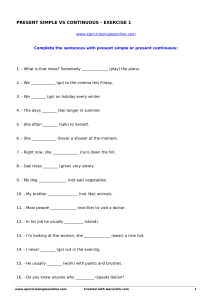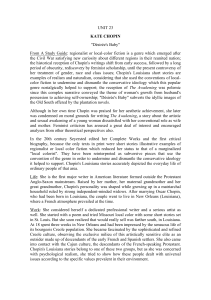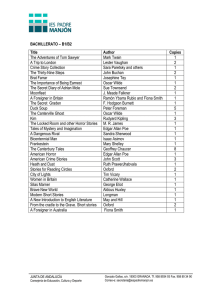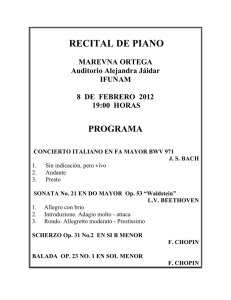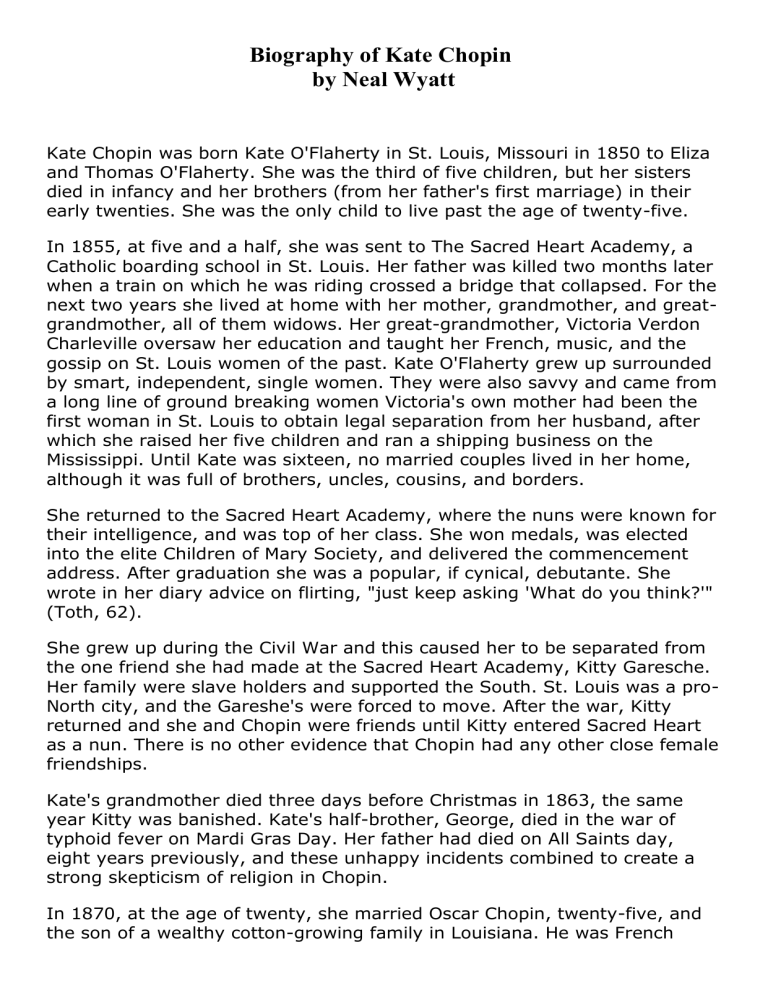
Biography of Kate Chopin by Neal Wyatt Kate Chopin was born Kate O'Flaherty in St. Louis, Missouri in 1850 to Eliza and Thomas O'Flaherty. She was the third of five children, but her sisters died in infancy and her brothers (from her father's first marriage) in their early twenties. She was the only child to live past the age of twenty-five. In 1855, at five and a half, she was sent to The Sacred Heart Academy, a Catholic boarding school in St. Louis. Her father was killed two months later when a train on which he was riding crossed a bridge that collapsed. For the next two years she lived at home with her mother, grandmother, and greatgrandmother, all of them widows. Her great-grandmother, Victoria Verdon Charleville oversaw her education and taught her French, music, and the gossip on St. Louis women of the past. Kate O'Flaherty grew up surrounded by smart, independent, single women. They were also savvy and came from a long line of ground breaking women Victoria's own mother had been the first woman in St. Louis to obtain legal separation from her husband, after which she raised her five children and ran a shipping business on the Mississippi. Until Kate was sixteen, no married couples lived in her home, although it was full of brothers, uncles, cousins, and borders. She returned to the Sacred Heart Academy, where the nuns were known for their intelligence, and was top of her class. She won medals, was elected into the elite Children of Mary Society, and delivered the commencement address. After graduation she was a popular, if cynical, debutante. She wrote in her diary advice on flirting, "just keep asking 'What do you think?'" (Toth, 62). She grew up during the Civil War and this caused her to be separated from the one friend she had made at the Sacred Heart Academy, Kitty Garesche. Her family were slave holders and supported the South. St. Louis was a proNorth city, and the Gareshe's were forced to move. After the war, Kitty returned and she and Chopin were friends until Kitty entered Sacred Heart as a nun. There is no other evidence that Chopin had any other close female friendships. Kate's grandmother died three days before Christmas in 1863, the same year Kitty was banished. Kate's half-brother, George, died in the war of typhoid fever on Mardi Gras Day. Her father had died on All Saints day, eight years previously, and these unhappy incidents combined to create a strong skepticism of religion in Chopin. In 1870, at the age of twenty, she married Oscar Chopin, twenty-five, and the son of a wealthy cotton-growing family in Louisiana. He was French catholic in background, as was Kate. By all accounts he adored his wife, admired her independence and intelligence, and "allowed" her unheard of freedom. After their marriage they lived in New Orleans where she had five boys and two girls, all before she was twenty-eight. Oscar was not an able business man, and they were forced to move to his old home in a small Louisiana parish. Oscar died of swamp fever there in 1882 and Kate took over the running of his general store and plantation for over a year. In 1884 she sold up and moved back to St. Louis to live with her mother. Sadly, Eliza died the next year, leaving Kate alone with her children again. To support herself and her young family, she began to write. She was immediately successful and wrote short stories about people she had known in Louisiana. The Awakeningwas inspired by a true story of a New Orleans woman who was infamous in the French Quarter. Her first novel, At Fault, was published in 1890, followed by two collections of her short stories, Bayou Folk in 1894 and A Night in Acadia in 1897. The Awakeningwas published in 1899, and by then she was well known as both a local colorist and a woman writer, and had published over one hundred stories, essays, and sketches in literary magazines. As a writer, Kate Chopin wrote very rapidly and without much revision. She usually worked in her home surrounded by her children. The content and message of The Awakening caused an uproar and Chopin was denied admission into the St. Louis Fine Art Club based on its publication. She was terribly hurt by the reaction to the book and in the remaining five years of her life she wrote only a few short stories, and only a small number of those were published. Like Edna, she paid the price for defying societal rules, and as Lazar Ziff explains, she "learned that her society would not tolerate her questionings. Her tortured silence as the new century arrived was a loss to American letters of the order of the untimely deaths of Crane and Norris. She was alive when the twentieth century began, but she had been struck mute by a society fearful in the face of an uncertain dawn" (Ziff, 305). While reading The Awakening remember that it is a kunstleroman, "a tale of a young woman who struggles to realize herself - and her artistic ability" (Huf, 69)and remember that Chopin, as well as Edna, was on a quest for artistic acceptance. That quest ended in an abrupt and frustrated manner when she died of a cerebral hemorrhage on August 22 1904. (Much of the above information was gathered from Kate Chopin by Emily Toth, Verging on the Abyss by Mary Papke, and Kate Chopin: A Critical Biography by Per Seyersted. Below is a chronology of her life and work taken from Dyer's The Awakening: A Novel of Beginnings, xii-xv) Chronology 1850 Born on February 8 to Eliza Faris O'Flaherty, a well connected St. Louisiana with French roots, and Captain Thomas O'Flaherty, a businessman from Ireland. 1855 Enters St. Louis Academy of the Sacred Heart. Father is killed in train accident. 1861 Confirmed in the Catholic Church by Archbishop Peter Richard Kenrick. 1863 Grandmother dies in January; half-brother George dies of typhoid fever. 1867 Begins keeping a commonplace book of poems, essays,sketches, criticism, etc. 1868 Graduates from Sacred Heart Academy. 1869-1870 Attends debutante parties, learns to smoke, and writes her first story, "Emancipation: A Life Fable," a short story about freedom and restriction. 1870 Marries Oscar Chopin; keeps journal of European honeymoon; moves to New Orleans; Oscar's father dies in November. 1871-1878 Has five sons, Jean, Oscar Charles, George, Frederick, and Felix. Oscar Charles becomes a professional cartoonist for the San Francisco Examinerand his daughter Kate, becomes a talented artist. 1879 Oscar closes his business in New Orleans and they move to Cloutierville where he runs several small plantations and a general store. 1882 Oscar dies of malaria, leaving Kate with a heavy debt and six young boys. 1883-1884 Kate tries to run Oscar's businesses and finally decides to move home to her mother's. 1885 Her mother dies. The attending doctor, Dr. Kolbenheyer, who is the model for Dr. Mandelet in The Awakening, continues to visit Chopin and encourage her writing. 1888 Begins reading Maupassant and writes "Euphrase." 1889 Publishes her first poem, "If It Might Be," in America. Writes four stories and publishes each of them. 1890-1892 Joins the Wednesday Club, founded by Charlotte Stearns Eliot, T.S Eliot's mother, but resigns two years later. Satire of club women appears in several of her stories, and in The Awakening in the depiction of Mrs. Highcamp's daughter. 1891 Writes "Mrs. Mobry's Reason" and "A Shameful Affair," which are published in the New Orleans Times-Democrat in 1893. Publishes more stories in Youth's Companion and Harper's Young People. 1894 Writes "A Respectable Woman" (Vogue) in January, introducing the character of Gouvernail, who reappears in The Awakening. Houghton Mifflin publishes Bayou Folk in March, and Chopin becomes nationaly known as a short story writer. 1897 A Night in Acadia, a second volume of short stories is published by Way and Williams of Chicago. 1897-1898 Writes The Awakening. 1899 The Awakening published by Herbert S. Stone and Company on April 22. 1900 Herbert S. Stone and Company reverses its decision to publish a third collection of short stories (it would not be published until Emily Toth's edition came out in 1991). Chopin writes four stories, only one of which is published. 1901 Writes and publishes only one story, "The Wood-Choppers." 1902 Publishes her last story, "Polly." 1904 Dies from a cerebral hemorrhage on August 22, after collapsing at the World's Fair, two days before.
